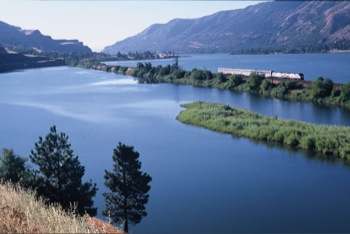
Photo courtesy Amtrak
It’s 10:30 on a clear Monday night in May, and the waiting salon at the Amtrak depot in St. Paul, Minnesota, is starting to fill up. In the general boarding area, a few dozen coach passengers sit in the waiting area; there are maybe a dozen more of us in the first-class lounge. We’re there because we’ve booked sleeper cars for our trip west. And when the train arrives in about a half-hour, we’ll be ready to call it a night.
I’m at the beginning of a five-day journey aboard the Empire Builder, one of Amtrak’s premier lines, which connects Chicago with Seattle and Portland, Oregon. I will spend tonight and tomorrow on the train, stepping off in Whitefish, Montana, late tomorrow night. The plan is to stop for a couple of days to explore Whitefish and nearby Glacier National Park, then to rejoin the Empire Builder and continue to its terminus in Portland.
At this time tomorrow night, I’ll be at a hotel in Whitefish. But what awaits in the next 24 hours — life on the train — is anyone’s guess.
Tuesday, 2:45 p.m.
Somewhere in Montana
Everything is more interesting on a train: sleeping, showering, eating and even getting from one place to another all feel different as you move down the railroad.
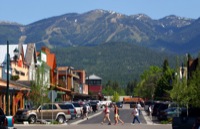 |
| By Brian Schott, courtesy Whitefish CVB |
I’m traveling in what the company calls a “roomette” — a cabin about 6 1/2 feet long and 3 1/2 feet wide. During the daytime, these small cabins are surprisingly roomy, with two large seats and a worktable in between. At night, the two seats fold down to form a bed, and a second one can be lowered from the ceiling.
Sleeping on a moving train, just like taking a shower or getting dressed, takes some getting used to. As it rolls down the tracks, the train sways gently back and forth, hitting some small bumpy patches along the way. At first, these unexpected movements can make simple tasks difficult; after a while though, they start to come more naturally.
My roomette also entitles me to use onboard showers and enjoy free meal service in the adjacent diner car. The meals served aboard the Empire Builder are hot, delicious and generously portioned. In the diner car, passengers eat at proper booths and tables and order drinks, entrees and desserts a la carte.
During meals, it’s not uncommon to be seated at a table with other passengers, and today during lunch, I ask some of my companions why they chose to make the multiday trip to the West Coast by train. James Newman, from northern Alabama, has traveled with Amtrak to New Orleans; Idaho; Chicago; and Memphis, Tennessee, and tells me that the train has become his favorite way to see the country.
“We take the train two or three times a year,” he says. “We used to fly, but it got to be too much of a hassle. I got tired of walking around the airport barefoot. On the train, you can relax and see more of the country.”
It takes nearly 48 hours to make the journey all the way from Chicago to Portland; from Minneapolis, where I joined the Empire Builder, it’s about 24 hours to Whitefish, where I’ll get off tonight.
Tuesday, 6:00 p.m.
Glacier Country
The Rocky Mountains come bursting out onto the plains without warning and almost out of nowhere.
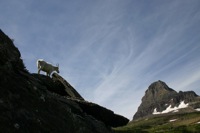 |
| By Brian Schott, courtesy Whitefish CVB |
We’ve been traveling on level ground for most of the day; all the way through North Dakota and much of Montana the landscape is flat, with only short moments of relief. But now, as we begin to approach Glacier National Park, the Rockies appear, dominating the distant skyline. And they are spectacular.
As we draw closer to the mountains, the landscape and vegetation around us begin to look different. A few miles out, foothills take shape; although it’s mid-May, there are patches of snow all along the side of the hills. The once-barren landscape is now abundant with cedar, birch, maple and pine. Streams run alongside the tracks. There are signs of life.
One of the great benefits of traveling by rail is the unshakable sense of grandeur that you get along the way. The Empire Builder cuts through Wisconsin, Minnesota, North Dakota, Montana, Washington and Oregon. All together, it stretches nearly 2,000 miles.
If you like, you can look out the window and see every one of them as you pass through.
Wednesday, 3:00 p.m.
Whitefish, Montana
A gooey mixture of cream and honey is causing flower petals to stick to the hair on my legs, and every few minutes, Maria stops rubbing my feet to peel the petals off my skin.
It’s not a familiar treatment, but my friends at the Whitefish Convention and Visitors Bureau have arranged for me to have a hot-stone foot massage at Remedies Day Spa, a company with spa locations throughout the Glacier Region of Montana. The company prides itself on using natural food products in all of its treatments, which is why my feet and lower legs are glazed in a cream-and-honey mixture and are being rubbed down for a good half-hour.
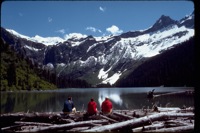 |
| Courtesy National Park Service |
“We use olive oil, corn meal, eggs, sugar and salt for most of our treatments here,” owner Jennifer Krack tells me. “You could eat just about everything we use here. I’m not sure it would taste good, but you could eat it.”
The spa is a popular attraction in Whitefish, a town of 7,000 located just outside of Glacier National Park. During the summer, some 10 million visitors will visit the million-acre park, and a good number of them will use Whitefish as their home base. As a result, the town has an eclectic mix of shops and services, from antique stores to outdoor outfitters, T-shirt shops and saloons.
I spend most of this morning exploring downtown, joining locals at a favorite coffee shop and visiting the shops that are only beginning to open for the season. Along the way, I check out the town’s performing arts center, as well as the museum at the rail depot, which has artifacts from the history of the Empire Builder.
As soon as Maria finishes with my legs, I’ll head out for a horseback trail ride at the Bar W Guest Ranch outside of town. The ranch excursion will be quite the departure from my spa experience. But contrast is one of the great things about Whitefish and probably one of the characteristics that make it a favorite return destination for visitors.
Whitefish is one of the most popular stopping points along the Empire Builder route, and I’m beginning to understand why.
Thursday, 11:00 a.m.
Glacier National Park
Sooner or later, we all have rainy days, even at times when we are hoping to see the sun.
Today I am scheduled to take a 4-mile hike around a lake in Glacier National Park with Jan Metzmaker, director of the Whitefish Convention and Visitors Bureau. The only problem is the weather — there’s a relentless rain outside. Rain is to be expected around here in mid-May, but the chilly temperatures, around 44 degrees, make the idea of a wet hike pretty unattractive.
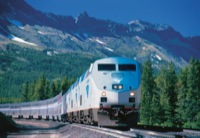 |
| Courtesy Amtrak |
Fortunately, Metzmaker knows the park well, and she takes me on a drive along the 10-mile shore of Lake McDonald, a beautiful scenic lake that was carved out by the movement of the park’s glaciers. We then stop by several sites around the park, such as the visitors center at Apgar, as well as some of Metzmaker’s favorite spots throughout. Along the way, she tells stories about local residents, visitors, park employees and the amazing things she has seen during her years here.
Several special events throughout the year in towns around the park are marking its centennial as part of the national park system.
In the end, we decide to make a short hike on a boardwalk that cuts through a densely wooded area of the park alongside some magnificent trees and a great rushing waterfall. The waterfall has the deep, crystalline blue glow that is the hallmark of glacial runoff, and it cuts through deep-red boulders on either side. It’s as scenic a spot as you’ll find anywhere and one of the hidden jewels of the park.
The rain is still falling overhead, but I realize that I’m enjoying myself anyway. After all, this is nature at its most natural. And I can’t argue with that.
Friday, 7:00 a.m.
Washington-Oregon border
The light comes streaming through the gaps in the curtains early this morning, and out the window of my sleeper car, I can see clear blue skies and the beautiful Columbia River flowing alongside the tracks. The river serves as the boundary between Washington and Oregon, and once we cross it, it will be just a few more hours until we reach the end of the line in Portland.
Looking across the river to the Oregon side, I see the small, craggy buttes slowly giving way to large rolling hills covered in vegetation. Soon, Mount Hood emerges in the distance. Tall, powerful and snow-covered, this peak dominates the landscape. The train moves slowly by, and we all get a good look.
After arriving in Portland today, I will grab a taxi to the airport and fly back east. It will be good to be home, but I think I will miss the train. I’ll miss the great food, the attentive staff and the slower pace of travel.
More than anything else, though, I’m going to miss the scenery. This is an intimate way to travel, a long study of the nuances of our countryside. Taking it in is like studying the lines and curves of a loved one’s face, at once familiar and surprising. And I am in no hurry to say goodb









